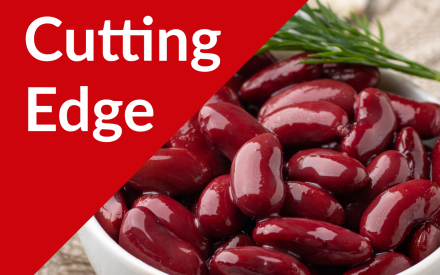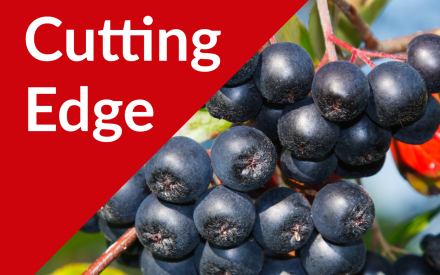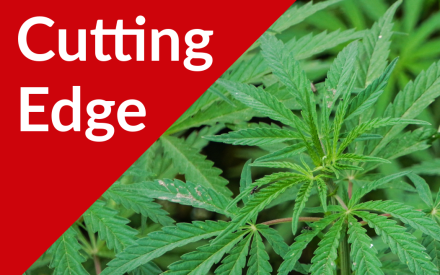Kicking off our series on agrivoltaics – the use of land for both agriculture and solar photovoltaic energy generation – is an interview with James McCall, Energy and Environment Analyst at the National Renewable Energy Laboratory (NREL). James gives an overview of the InSPIRE project, which explores the environmental compatibility and mutual benefits of solar development with agriculture and native landscapes. The InSPIRE project is funded by the US Department of Energy and managed by NREL.
Transcript
JASON FISCHBACH 0:00
This is a podcast about new crops. You’re gonna love it. Join us on The Cutting Edge, a podcast in search of new crops for Wisconsin.
Steffen Mirsky 0:09
Hello and welcome to The Cutting Edge. I’m Steffen Mirsky, Outreach Specialist for emerging crops with UW Madison Extension. In this three part series, we’re talking all about agrivoltaics. If you haven’t heard of it, you’ll want to listen because it might be coming to a farm near you in the near future. For this series, I teamed up with one of my extension colleagues Will Fulwider who hosts his own podcast. In the first episode, we talked with James McCall, a senior analyst with the National Renewable Energy Laboratory to learn about the federally supported InSPIRE program. But before we dive in, Will, do you want to introduce yourself to our Cutting Edge listeners?
Will Fulwider 0:50
Yeah, sure. My name is Will Fulwider. I’m a Regional Crops Educator with UW Extension for Dane and Dodge counties. I run a podcast as well called Field Notes, which is co hosted by Michael Geissinger of the UW Nutrient and Pest Management Program. And we kind of cover, like, you know, production agriculture topics and practices and cover crops and everything like that. So I’m excited to be teaming up on this exciting topic of agrivoltaics.
Steffen Mirsky 1:18
Cool, awesome. Well, Will, I’m so glad we can collaborate on this together.
Will Fulwider 1:22
But let’s slow down a second. What is agrivoltaics?
Steffen Mirsky 1:26
As I understand it, agrivoltaics is the co-location of solar panels and agriculture. It’s a pretty hot topic right now, so I’m really excited to talk about it today.
Will Fulwider 1:36
Yeah, I mean, we’ve got a lot of people that we are going to talk about it with. We should get started.
James McCall 1:42
Yeah, we definitely should. My name is James McCall. And I’m an Energy and Environment Analyst at the National Renewable Energy Laboratory. I’ve been there about eight years and have been working on agrivoltaics, or agrivoltaics systems for most of my time here doing a lot of technical economic modeling of different kind of scenarios, and also trying to quantify the environmental impacts of these different systems.
Steffen Mirsky 2:11
So you work on the InSPIRE program, which is kind of a nationwide program that tries to figure out some of the best practices around agrivoltaics. Can you just give a quick overview of the program?
James McCall 2:25
Absolutely. Inspire stands for innovative solar practices integrated with rural economies and ecosystems. And we are funded by the US Department of Energy, their solar energy, energy technology office to kind of be a research consortium for a lot of different project partners. So we work with other national labs such as Argonne National Laboratory developers, and also kind of NGOs and other kinds of people across the landscape of agricultural systems. And we’re really trying to kind of perform research to inform different animal takes scenarios. And we define agrivoltaics as the integration of basically some dual land use practices with solar, mainly, the creation of habitat, generally done through pollinators and other types of animals, integration of grazing, such as sheep, which is fairly prominent in the US and elsewhere in the world, and then also integrating crops and kind of different designs. And so NREL really serves as a convening member to make sure that similar research methodologies being performed at different sites throughout the United States. So we currently have as a part of the InSPIRE project, roughly 25 different sites throughout the country, spanning all kinds of geographies, and kind of looking at different things at different sites. So you know, we have a few sites, looking at crops in Colorado, Massachusetts, and Arizona. And then we have other sites looking at pollinator habitat and vegetation underneath panels and other sites that are looking at grazing in particular with our partners from the American Solar grazing association. So this is our, I believe, eighth year of research. And it’s really been segmented into two or three different kinds of pieces. And as agrivoltaics has kind of come to prominence as a solution, it has kind of shifted our research focus away from more of the academic research towards this practical, kind of like large scale scale up.
Steffen Mirsky 4:40
Well, what would you say are some of the most important things that you’ve learned so far in this project that you’ll apply going forward?
James McCall 4:48
Absolutely. I think one of the main things that we’ve learned is that there is kind of a lot of interest in this space, and it’s really about the communication of these different concepts to kind of different groups. You know, kind of how do solar developers in the solar industry communicate to farmers. And those are two very different operations. And I think one of the largest things that we’re learning is that there really, at least, we have not found as of yet kind of any optimal solution that you’re just going to plug and play repeat every single time. Like this is really super dependent on, you know, the climate that you have on the kind of the cost considerations to go in. And in the design, it is, you know, this, this relationship between the developer and the farmer is, is kind of very important. And you know, how you navigate this, you know, the developers are not used to people being on site constantly, every day. And, you know, farmers are not used to having giant steel beams in the middle of their fields. So it’s really about just this, this, this trying to define a solution based on what the parties kind of need. A great example of this is we have a site in Arizona, and for the most part, we are showing very consistent effects have shade on these kinds of crops. And that’s, you know, leading to crop yield, or crop yield increases, water decreases. It’s the desert, it’s difficult to grow things. Whereas in our site in Massachusetts, in wet cold years, we’re actually seeing a reduction of yield underneath panels. But in hot and dry years, we’re actually seeing an increase. And so it’s kind of this, the same system, the same crops, just different areas, it’s just kind of very different. And I think that we’re seeing that the sites can be economic, if there are certain kind of, you know, conditions that already exist, but that we are not going to just plaster farmland with solar and crops and kind of expect to turn a profit. The tool needs to be used in the correct application. And I think that that’s kind of where we get to the point where crops, grazing and pollinator habitat kind of provide a lot of different solutions to kind of meet similar goals.
Will Fulwider 7:04
And so it sounds like it’s a really a case by case basis is kind of how you have to take it or at least a climate by climate type of basis. And so I guess, are you all kind of trying to create some sort of method of approaching an agrivoltaics kind of solution, like, oh, if you’re in this area, under these soils, this is what might work or like a flowchart of ideas? I don’t know, like some sort of way forward to help developers and farmers find tenable solutions.
James McCall 7:38
Yeah, I think that that is kind of where a lot of the endpoints of our research is. It’s kind of really data and foundational science, to kind of inform that type of piece. And yeah, it’s about like, Okay, we have this, this configuration of solar, here’s going to be the amount of land that you can still farm, here’s going to be the amount of energy that you’re going to produce off this, here’s going to be the shading impacts on these crops, and kind of really just trying to kind of create this knowledge base, to kind of then allow, you know, other entities to use that information, either a great tools or kind of tools that we’ve used to kind of help that. And so that’s, I think that that is the endpoint.
Steffen Mirsky 8:19
Great. So I’m wondering, like, what kind of methods are you using to determine what the priority areas are for research? Are you getting feedback from farmers, and from developers to inform this kind of thing?
James McCall 8:36
Yeah, I think that that is kind of one of the one of the largest things that kind of the, at least the National Lab System can kind of bring to some of this research is really being this kind of independent source of information, and we can really talk to a lot of different people, and kind of get feedback from a lot of this. And so, yes, we are working with agricultural entities throughout the country, you know, we’re working with, you know, Department of Agriculture, both at the federal and the state level, we’re working with individual farmers and really kind of seeing about, okay, the, you know, how do we actually translate our research findings to their 10 acre plots? And so I think that I think that that, you know, as we’ve kind of gone along, it’s been a learning exercise for us, you know, speaking energy to agriculture is very complicated, and vice versa. And so it’s like the, the kind of trying to figure out the who are these partners, and like, in particularly from the, you know, within the community, like, I remember an interaction where we were working in Pennsylvania, and I pointed to an example in Ohio, like right across the border, and they’re like, well, this is Pennsylvania, this isn’t Ohio. And so it’s like, that is a completely valid point. And so it’s about how do you kind of find that person that is trusted within the community to kind of have that, and I think that being that independent voice can kind of help kind of find that sometimes.
Will Fulwider 10:08
Yeah, and, you know, I work with a lot of farmers in, in rural areas often and, you know, solar is not often welcomed with open arms. And so part of my, like, wishes for agrivoltaics is to, you know, solar is going to be sited in rural areas, and it’s, it’s coming more or less for some, some parts of the United States and to be able to continue some sort of agriculture in those areas that maybe previously we hadn’t thought possible. And so my question is kind of like, what are the farmers think, you know, what is some of the responses from the stakeholders that you mentioned, and then also, folks that are doing a little bit more of the actual planting and work on some of these sites? What is their response?
James McCall 10:54
Yeah, I think it’s, it’s a little bit of across the spectrum of, of kind of the response, there are some people who want to be kind of the voice of, you know, basically, the kind of solution within the community like, like, they want to do this to show people that it can be done. There are others that are very skeptical, and you know, even I think we were working with or had heard from, like a dairy farmer in the northeast, that was just like, I know that I can graze my animals underneath this, but I don’t want to do that. So I’m just basically selling on my own. And so I think it’s, I think it kind of runs the gamut across a lot of these kinds of different responses. And I think that, but the one common thing that we are hearing is that solutions that enable kind of this way of life to continue, and to kind of basically to get this agreed upon structure in which we can continue food production, and also supplement with energy is basically needed. You know, we have been working with some kind of county entities that they are very interested in agrivoltaics and about two months into the project, they have now passed an ordinance that there’s no solar being cited in this area, and then you kind of gotta move on. And so that’s, that is, I think, becoming common and is kind of, I think, one area where this solution is going to pop up. And we’re also seeing state responses to this in that either, you know, as in Illinois where they’re actually offering you know, a little more money for the energy produced per kilowatt hour produced if you do certain kinds of things, or in Massachusetts, where there’s kind of an ad or to your power purchase agreement price, or I think Colorado just passed a law that it’s basically a grant to kind of cover some of these kinds of expenses that actually go into actually raising the panels. And so this was a lot of the levers that are kind of popping up.
Steffen Mirsky 12:49
Great. So I’m wondering how the results and information that’s come out of the project so far, is being communicated to people?
James McCall 12:59
Yeah, I think that, I mean, a lot of it is just kind of the it’s been outreach through kind of our research group and kind of project partners. And, you know, we, we have been very fortunate to work with Agrisolar Clearinghouse as kind of this trusted entity to reach this farming audience and kind of these other agricultural entities. So we do kind of webinars with them, we do joint kind of tours that people can actually come out and kind of see the solar facility, you know, we kind of sponsor tours throughout Colorado and kind of some other areas, but then we also partner with a lot of extension schools. And again, I think, I think our role has really been to provide this information in kind of, like, whatever setting is kind of needed, you know, and oftentimes, that these personally, I have found the best luck of showing up, you know, and seeing someone’s land or for them to kind of come out and actually see the site that is just a very powerful thing about to see like, you know, the, like when you look at it on paper, or kind of like the concept is like how can these two things actually coincide together and until you actually see it and kind of actually see it in your community? I think that there’s going to be kind of this barrier and so it’s really about this kind of more of an all all of the above approach.
Steffen Mirsky 14:25
Well, thanks to James for joining us, and thank you for listening. And remember to tune in to parts two and three of the series on agrivoltaics as Will and I talk with representatives from UW and Alliant Energy, about the UW Kegonsa Solar Farm Project, which is about to break ground this fall. And then we get into more of the nuts and bolts of farming under solar panels in part three, as we talk with extension researchers and solar developers in Ohio and Minnesota.
JASON FISCHBACH 14:56
Brought to you by the University of Wisconsin Madison Division of Extension.


 The Cutting Edge Podcast Episode #37: Chippewa Valley Bean
The Cutting Edge Podcast Episode #37: Chippewa Valley Bean The Cutting Edge Podcast Episode #36: Aronia Berry Markets
The Cutting Edge Podcast Episode #36: Aronia Berry Markets The Cutting Edge Podcast Episode #35: A Ho-Chunk Perspective on Hemp
The Cutting Edge Podcast Episode #35: A Ho-Chunk Perspective on Hemp The Cutting Edge Podcast Episode #53: Hemp Research Priorities at UW-Madison with Dr. Shelby Ellison
The Cutting Edge Podcast Episode #53: Hemp Research Priorities at UW-Madison with Dr. Shelby Ellison


